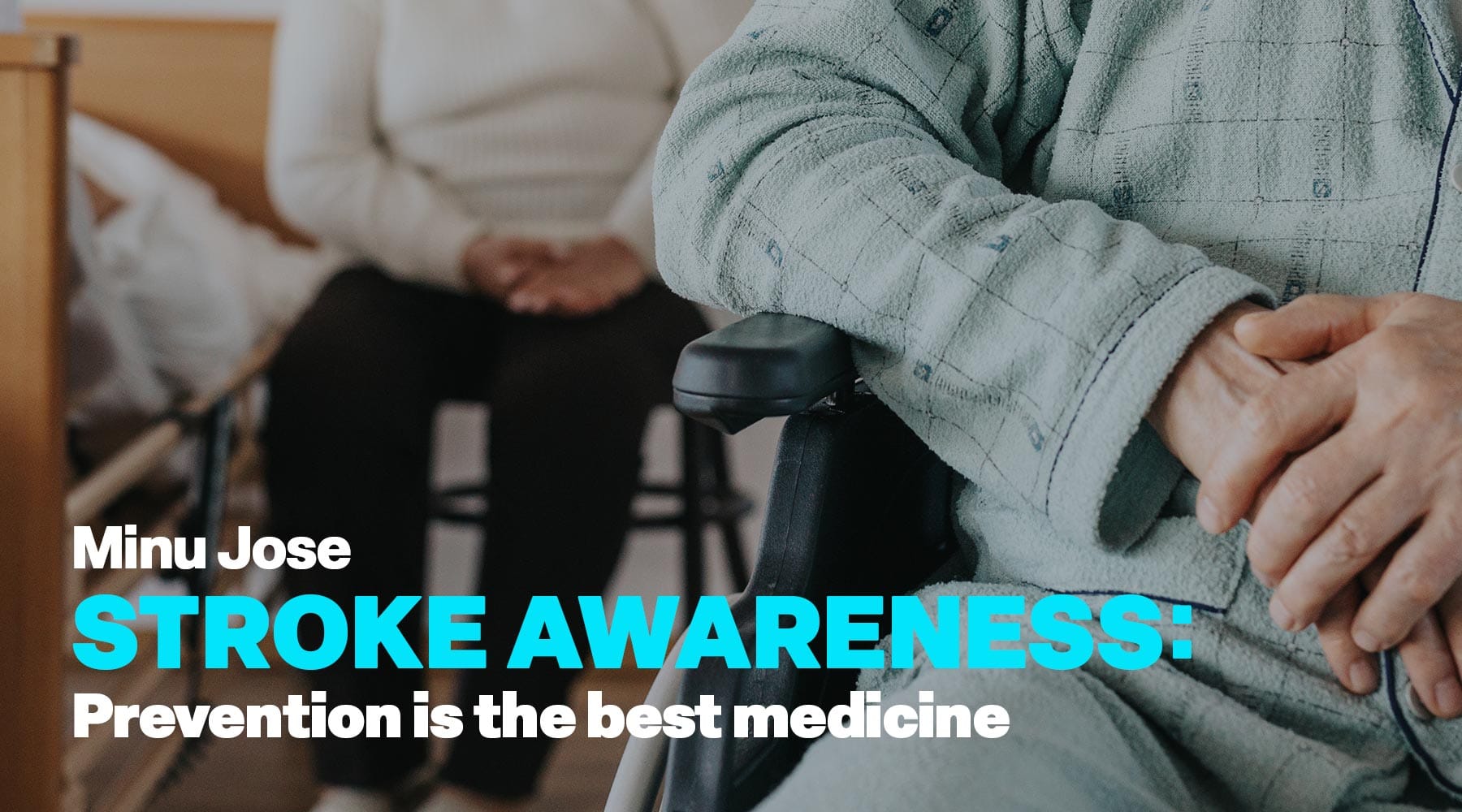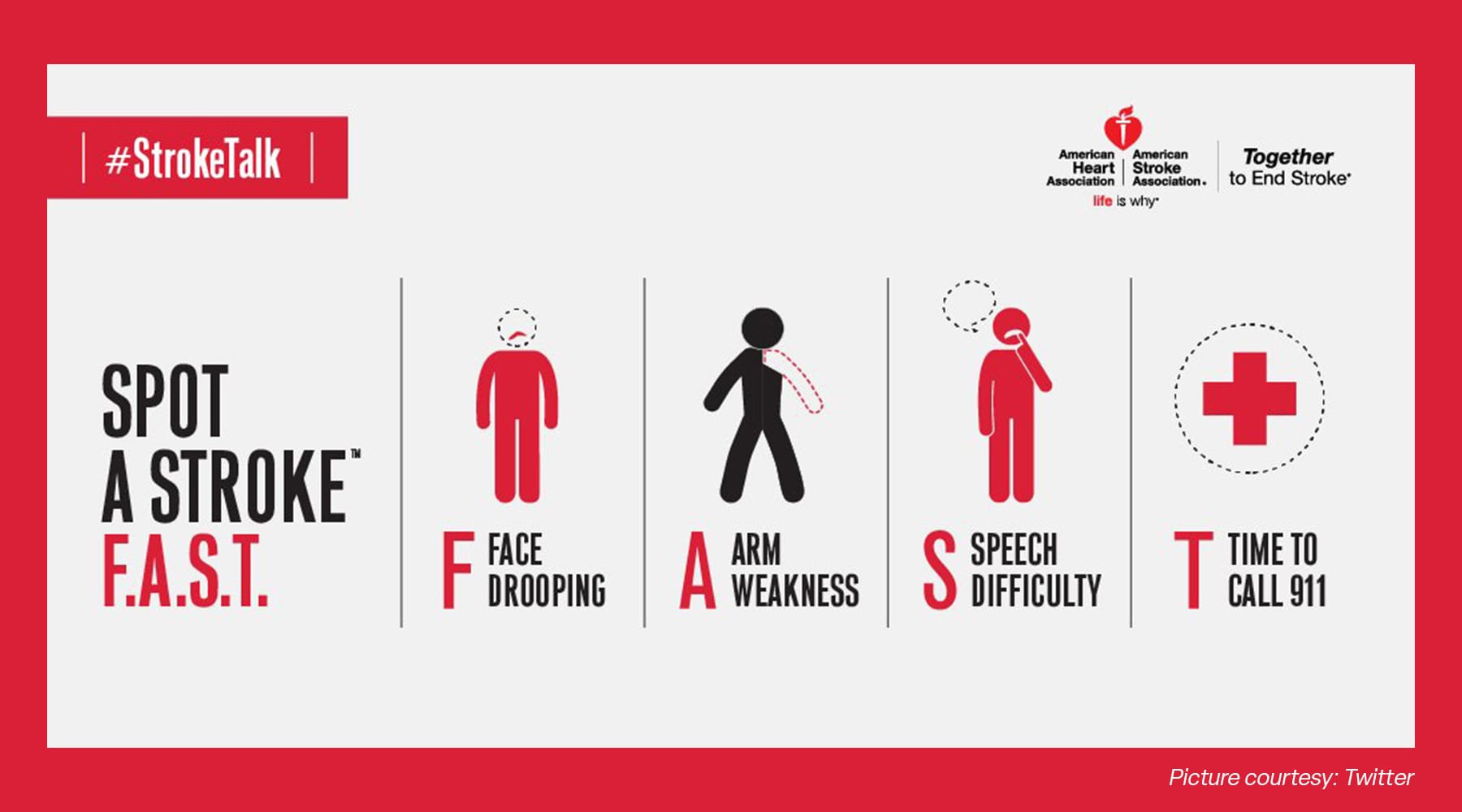A stroke happens in America every 40 seconds, and someone dies of it every four minutes!
In the United States, every year, the month of May is observed as the National Stroke Awareness Month. This is to create public awareness about stroke risk factors and to lessen the occurrence of strokes in the U.S.
Many people think a stroke happens in the heart, but it happens in the brain.
Stroke is the No. 5 cause of death and a leading cause of disability in the United States. Stroke is a disease that affects the arteries leading to and within the brain. A stroke occurs when a blood vessel that carries oxygen and nutrients to the brain is either blocked by a clot or bursts (or ruptures). When that happens, part of the brain cannot get the blood (and oxygen) it needs, so the brain cells die.
Many people think a stroke happens in the heart, but it happens in the brain.
Types of stroke
Ischemic Stroke (Clots)
Occurs when a blood vessel supplying blood to the brain is obstructed. It accounts for 87 % of all strokes.
Hemorrhagic Stroke (Bleeds)
Occurs when a weakened blood vessel ruptures. The two types of hemorrhagic strokes involving weakened blood vessels are aneurysms and arteriovenous malformations (AVM). The most common cause of hemorrhagic stroke is uncontrolled high blood pressure.
TIA (Transient Ischemic Attack)
Called a mini-stroke, it’s caused by a serious temporary clot. This is a warning sign of stroke and should be taken seriously.
Cryptogenic Stroke
In some instances, despite testing, the cause of a stroke can’t be determined. This is called a cryptogenic stroke.
Brain Stem Stroke
When a stroke occurs in the brain stem, it can affect both sides of the body and may leave someone in a ‘locked-in’ state. In this state, the patient is, generally, unable to speak or move their(his/her) body below the neck.
Effects of stroke
The brain is an extremely complex organ that controls various body functions. If a stroke occurs and blood flow can’t reach the region that controls a particular body function, that part of the body won’t work as it should. The effects of a stroke depend primarily on the location of the obstruction and the extent of brain tissue affected.
Can recognizing a stroke save your life?
If you’re having a stroke, it’s critical that you get medical attention right away. Immediate treatment may minimize the long-term effects of a stroke and even prevent death. Thanks to recent advancements in medical science, stroke treatments and survival rates have improved greatly over the last decade.
At the same time, in order to seek treatment, you must recognize the signs and symptoms of a stroke and know what to do.
Warning Signs
-
- Numbness or weakness in your face, arm, or leg, especially on one side
- Confusion or trouble understanding other people
- Difficulty speaking
- Trouble seeing with one or both eyes
- Problems walking or staying balanced or coordinated
- Dizziness
- Severe headache that comes on for no reason
Spotting the warning signs and early symptoms of a stroke is key to reducing the risk of permanent disability or death when the disease strikes. But do you know what to look for?
If you think someone may be having a stroke, act F.A.S.T. and do the following test:
- F—Face: Ask the person to smile. …
- A—Arms: Ask the person to raise both arms. …
- S—Speech: Ask the person to repeat a simple phrase. …
- T—Time: If you see any of these signs – drooping face, arm drift and slurred speech – call 9-1-1 right away.
- Note the time when any symptoms first appear.
American Heart Association National President elect Dr Mitchell Elkind, M.D. (a professor of neurology and epidemiology at Columbia University), however, likes to tack on two additional letters ahead of the acronym: B and E. These stand for “balance” and “eyes,” since a loss of balance and a sudden change in vision can also signal a stroke.
While strokes cannot be predicted, you can take proactive measures to decrease your chances of suffering from one. Factors, such as high blood pressure, smoking, vascular disease, and diabetes increase the odds of a stroke. However, habits like checking your cholesterol, blood sugar regulation, regular exercise, and maintaining a healthy weight help lower stroke risk. In 2018, a study showed that women who ate a Mediterranean diet decreased their stroke risk by more than 22 percent. Your doctor can discuss more options with you about stroke prevention that would suit your needs and lifestyle the best.
7 things you can do to prevent a stroke
1. Lower blood pressure
High blood pressure is a huge factor, doubling or even quadrupling your stroke risk, if it is not controlled. High blood pressure is the biggest contributor to the risk of stroke in both men and women. Monitoring blood pressure and, if it is elevated, treating it, is probably the biggest difference people can make to their vascular health.
Your goal: An ideal goal is maintaining a blood pressure of less than 120/80. But there may be good reasons why you and your doctor will not want your readings to be this low. For some, a less aggressive goal (such as no higher than 140/90) may be more appropriate.
How to achieve it:
- Reduce the salt in your diet to no more than 1,500 milligrams a day (about a half teaspoon).
- Avoid high-cholesterol foods, such as burgers, cheese, and ice cream.
- Eat 4 to 5 cups of fruits and vegetables every day, one serving of fish two to three times a week, and several daily servings of whole grains and low-fat dairy.
- Get more exercise — at least 30 minutes of activity a day, and more, if possible.
- Quit smoking, if you smoke.
- If needed, take blood pressure medications.
2. Lose weight
Obesity, as well as the complications linked to it (including high blood pressure and diabetes), raises your odds of having a stroke. If you’re overweight, losing as little as 10 pounds can have a real impact on your stroke risk.
Your goal: While an ideal body mass index (BMI)is 25 or less, that may not be realistic for you. Work with your doctor to create a personal weight loss strategy.
How to achieve it:
- Try to eat no more than 1,500 to 2,000 calories a day (depending on your activity level and your current BMI).
- Increase the amount of exercise you do with activities like walking, golfing, or playing tennis, and by making such activities part of every single day.
3. Exercise more
Exercise contributes to losing weight and lowering blood pressure, but it also stands on its own as an independent stroke reducer.
Your goal: Exercise at a moderate intensity at least five days a week.
How to achieve it:
- Take a walk around your neighborhood every morning after breakfast
- Visit/frequent a fitness club with friends
- When you exercise, reach the level at which you’re breathing hard, but you can still talk
- Take the stairs instead of an elevator when you can
- Take a walk around your neighborhood every morning after breakfast
- If you don’t have 30 consecutive minutes to exercise, break it up into 10- to 15-minute sessions a few times each day
4. If you drink alcohol — do it in moderation
Drinking a little alcohol, such as an average of one per day, is okay. Once you start drinking more than two drinks per day, your risk goes up very sharply.
Your goal: Don’t drink alcohol, or do it in moderation.
How to achieve it:
- Have no more than one glass of alcohol a day
- Consider red wine as your first choice, which some studies suggest might help prevent heart disease and stroke
- Watch your portion sizes. A standard-sized drink is a 5-ounce glass of wine, 12-ounce beer, or 1.5-ounce glass of hard liquor
5. Treat atrial fibrillation
Atrial Fibrillation is a form of irregular heartbeat that causes clots to form in the heart. Those clots can, then, travel to the brain, producing a stroke. Atrial fibrillation carries almost a fivefold risk of stroke, and should be taken seriously.
Your goal: If you have atrial fibrillation, get it treated.
How to achieve it:
- If you have symptoms such as heart palpitations or shortness of breath, see your doctor for an exam
- You may need to take an anticoagulant drug (blood thinner), such as one of the direct-acting anticoagulant drugs to reduce your stroke risk from atrial fibrillation. Your doctors can guide you through this treatment
6. Treat diabetes
Having high blood sugar damages blood vessels over time, making clots more likely to form inside them.
Your goal: Keep your blood sugar under control.
How to achieve it:
- Monitor your blood sugar as directed by your doctor
- Use diet, exercise, and medicines to keep your blood sugar within the recommended range
7. Quit smoking
Smoking accelerates clot formation in a couple of different ways. It thickens your blood, and it increases the amount of plaque buildup in the arteries. Along with a healthy diet and regular exercise, smoking cessation is one of the most powerful lifestyle changes that will help you reduce your stroke risk significantly.
Your goal: Quit smoking.
How to achieve it:
- Ask your doctor for advice on the most appropriate way for you to quit
- Use quit-smoking aids, such as nicotine pills or patches, counseling, or medicine
- Don’t give up. Most smokers need several tries to quit. See each attempt as bringing you one step closer to successfully beating the habit
References
- Harvard health publishing
- AARP health journal
- AHA journals
- www.stroke.org





